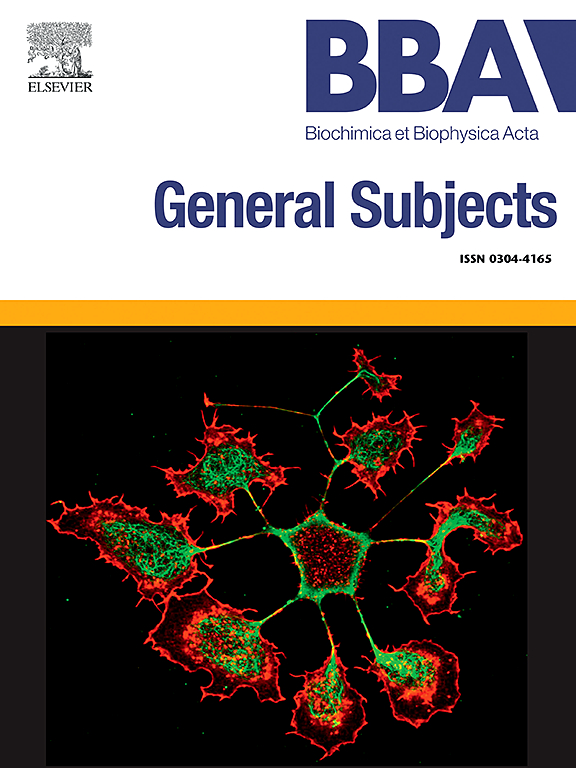毒蕈碱受体与蛋白激酶C的偶联是细胞对乙酰胆碱反应的反馈调节的基础。
IF 2.2
3区 生物学
Q3 BIOCHEMISTRY & MOLECULAR BIOLOGY
Biochimica et biophysica acta. General subjects
Pub Date : 2025-07-24
DOI:10.1016/j.bbagen.2025.130844
引用次数: 0
摘要
乙酰胆碱(ACh)诱导的Ca2+信号传导在HEK-293 (WT-HEK)细胞及其衍生物IP3R1- hek、IP3R2- hek和IP3R3- hek中分别具有单一功能IP3受体异构体IP3R1、IP3R2或IP3R3。WT-HEK细胞的初始刺激触发了一个延长的反馈过程,降低了它们对乙酰氨基酚的反应性。用Gö 6983或calphostin C抑制蛋白激酶C (PKC)可阻止乙酰胆碱反应性的下降,表明PKC参与其中。使用IP3R1-HEK、IP3R2-HEK和IP3R3-HEK细胞,我们发现PKC能够通过IP3R各亚型调节Ca2+释放。而在对照组中,IP3释放触发了约15% %的携带cage - ins (145)P3/PM的细胞中的Ca2+瞬态,PKC抑制使这一比例增加了近两倍。这些观察结果表明,在ACh转导机制中,PKC主要针对ip3驱动的Ca2+释放。ADP和5-HT分别在表达内源性P2Y和重组5HT2C受体的WT-HEK细胞和CHO细胞中触发Ca2+瞬态。初始细胞刺激后,WT-HEK细胞对ADP和CHO细胞对5-HT的反应性依次下降,但PKC抑制几乎完全阻止了这一现象。利用实时荧光成像技术和PKC活性基因编码传感器sapphirecar,首次证实了gpcr与活细胞中的PKC、WT-HEK细胞中的毒菌碱和P2Y受体以及CHO细胞中的5HT2C受体的偶联。总之,我们的研究结果表明,基于pkc的激动剂诱导的Ca2+释放的反馈调节可能是各种激动剂转导的共同属性,这些激动剂涉及gpcr偶联到磷酸肌苷级联。本文章由计算机程序翻译,如有差异,请以英文原文为准。
Coupling of muscarinic receptors to protein kinase C underlies a feedback regulation of cell responsiveness to acetylcholine
Acetylcholine (ACh)-induced Ca2+ signaling was analyzed in HEK-293 (WT-HEK) cells and their derivatives, IP3R1-HEK, IP3R2-HEK, and IP3R3-HEK with a single functional IP3 receptor isoform, IP3R1, IP3R2, or IP3R3, respectively. The initial stimulation of WT-HEK cells triggered a prolonged feedback process that diminished their responsiveness to ACh. Inhibition of protein kinase C (PKC) with Gö 6983 or calphostin C prevented the decline of ACh responsivity, indicating that PKC was involved. Using IP3R1-HEK, IP3R2-HEK, and IP3R3-HEK cells, it was shown that PKC was capable of regulating Ca2+ release through each IP3R isoform. While in control, IP3 uncaging triggered Ca2+ transients in ∼15 % of cells loaded with caged-Ins(145)P3/PM, PKC inhibition enlarged this fraction nearly twofold. These observations suggested that in ACh transduction machinery, PKC targeted primarily IP3-driven Ca2+ release. ADP and 5-HT triggered Ca2+ transients in WT-HEK cells and CHO cells expressing endogenous P2Y and recombinant 5HT2C receptors, respectively. The responsiveness of WT-HEK cells to ADP and CHO cells to 5-HT applied serially declined after the initial cell stimulation but PKC inhibition precluded this phenomenon almost completely. The coupling of GPCRs to PKC in living cells, muscarinic and P2Y receptors in WT-HEK cells and 5HT2C receptors in CHO cells, was demonstrated for the first time using real-time fluorescence imaging and sapphireCKAR, a genetically encoded sensor of PKC activity. Altogether, our findings suggest that a PKC-based feedback regulation of agonist-induced Ca2+ release might be a common attribute of transduction of various agonists involving GPCRs coupled to the phosphoinositide cascade.
求助全文
通过发布文献求助,成功后即可免费获取论文全文。
去求助
来源期刊

Biochimica et biophysica acta. General subjects
生物-生化与分子生物学
CiteScore
6.40
自引率
0.00%
发文量
139
审稿时长
30 days
期刊介绍:
BBA General Subjects accepts for submission either original, hypothesis-driven studies or reviews covering subjects in biochemistry and biophysics that are considered to have general interest for a wide audience. Manuscripts with interdisciplinary approaches are especially encouraged.
 求助内容:
求助内容: 应助结果提醒方式:
应助结果提醒方式:


